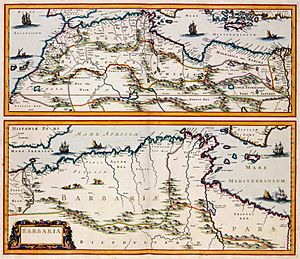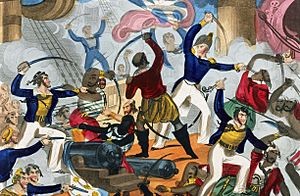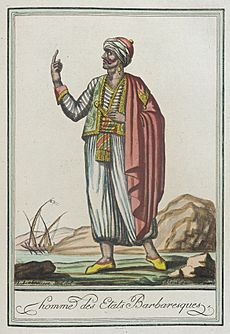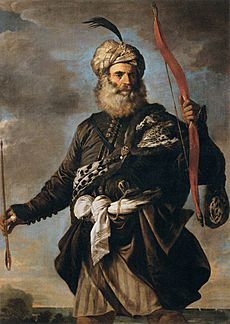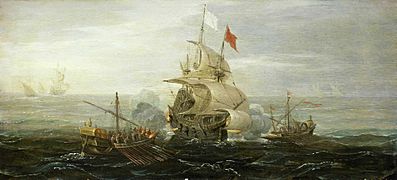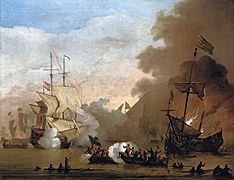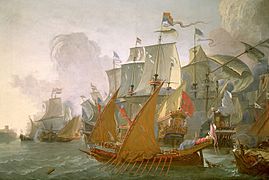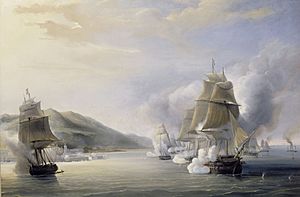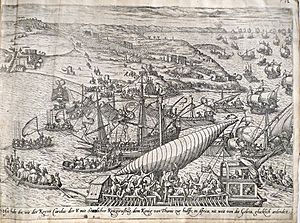Barbary pirates facts for kids
The Barbary pirates were a group of pirates and privateers. They mostly came from the Barbary States in North Africa. This region was known in Europe as the Barbary Coast. It got its name from the Berbers, who lived there.
Their main goal was to capture people and sell them as slaves. These slaves came from many different backgrounds and religions. They could be Christian, Jewish, or Muslim. The pirates operated all over the Mediterranean Sea. They also sailed south along West Africa's Atlantic coast. Sometimes, they even went as far north as Iceland.
Besides attacking merchant ships, they also raided European towns. These raids, called razzias, happened mostly in Italy, France, Spain, and Portugal. But they also reached places like the British Isles, the Netherlands, and Iceland.
Pirate raids had happened since the 700s. But the terms "Barbary pirates" and "Barbary corsairs" usually refer to those active from the 1500s. This is when their attacks became more frequent and widespread. During this time, Algiers, Tunis, and Tripoli became part of the Ottoman Empire. They were either direct provinces or self-governing areas. Similar raids also came from Salé and other ports in Morocco.
Barbary corsairs captured thousands of merchant ships. They also raided coastal towns many times. Because of this, people left their homes along long parts of the Spanish and Italian coasts. Between 100,000 and 250,000 people from the Iberian Peninsula were enslaved by these raids.
The raids were such a big problem that few new coastal towns were built until the 1800s. Some historians say that between 1580 and 1680, about 850,000 people were captured as slaves. From 1530 to 1780, this number might have been as high as 1.25 million. However, some historians like David Earle have questioned these numbers.
Some of these corsairs were Europeans who had changed their religion. They were called "renegades." Famous ones include John Ward and Zymen Danseker. Hayreddin Barbarossa and Oruç Reis, known as the Barbarossa brothers, were also famous corsairs. They took control of Algiers for the Ottomans in the early 1500s. Around 1600, European pirates brought new sailing and shipbuilding skills to the Barbary Coast. This allowed the corsairs to raid further into the Atlantic Ocean. The Barbary raids were most active in the early to mid-1600s.
Many Barbary warships were galleys. These were ships powered by oars, carrying many fighters with cutlasses and small guns. European ships, however, had moved to sailing ships with powerful cannons. The Barbary navies were not built for big battles. They would usually flee if they saw a strong European frigate.
The corsairs' activity began to slow down in the late 1600s. Stronger European navies started to force the Barbary States to make peace. But ships and coasts of Christian states without strong protection still suffered until the early 1800s. Between 1801 and 1815, there were some conflicts. This included two Barbary wars fought by the United States, Sweden, and the Kingdom of Sicily.
After the Napoleonic Wars and the Congress of Vienna in 1814–15, European powers agreed to stop the Barbary corsairs completely. The threat finally ended with the French conquest of Algeria in 1830. The French then brought peace to the region during the mid-to-late 1800s.
Contents
History of the Barbary Pirates
Barbary pirates were active for a very long time, from the medieval times until the 1800s.
Early Pirate Raids
In 1198, Barbary piracy and slave-taking were such a big problem that a religious group called the Trinitarians was formed. Their job was to collect money to free captives. They would even offer themselves as ransom for those enslaved in North Africa.
In the 1300s, Tunisian corsairs became a big enough threat to cause an attack on Mahdia in 1390. This was known as the "Barbary Crusade." People exiled from Spain and pirates from North Africa joined the corsairs. But they became a real danger to European Christian ships only after the Ottoman Empire grew. This also happened when the privateer Kemal Reis arrived in 1487.
The 1500s: A Time of Growth
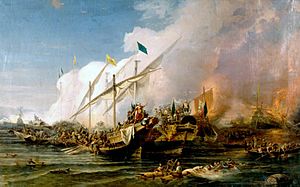
From 1559, the North African cities of Algiers, Tunis, and Tripoli were part of the Ottoman Empire in name. But they were actually like military republics. They chose their own leaders and lived by taking treasures from the Spanish and Portuguese. Some Sephardic Jews, like Sinan Reis and Samuel Pallache, who fled Spain, also attacked Spanish ships under the Ottoman flag.
In the early period (1518–1587), the leaders, called beylerbeys, were admirals for the sultan. They led large fleets and fought wars for political reasons. They were known for capturing slaves and were very fierce. After 1587, their main goal became simply to get rich from plunder.
The sea operations were led by captains, or reises. These captains formed a special group. Ships were prepared by investors and commanded by the reises. Ten percent of the value of anything captured went to the local ruler, who was called a pasha, agha, dey, or bey.
In 1544, Hayreddin captured the island of Ischia, taking 4,000 prisoners. He also enslaved 2,000–7,000 people from Lipari. In 1551, Turgut Reis enslaved everyone on the Maltese island of Gozo, about 5,000 to 6,000 people. He sent them to Ottoman Tripolitania. In 1554, corsairs led by Turgut Reis attacked Vieste. They killed 5,000 people and took another 6,000 as captives.
The 1600s: Raids on European Coasts

In 1607, the Knights of Saint Stephen attacked Bona in Algeria. They killed 470 people and took 1,464 captives. This victory is remembered in paintings in the Palazzo Pitti in Florence. In 1611, Spanish ships from Naples and the Knights of Malta raided the Kerkennah Islands off Tunisia. They took almost 500 Muslim captives. Between 1568 and 1634, the Knights of Saint Stephen may have captured about 14,000 Muslims. Most were taken from ships, and some from land raids.
Ireland also suffered attacks. In June 1631, Murat Reis and corsairs from Algiers attacked the village of Baltimore, County Cork. They captured almost all the villagers and took them to North Africa as slaves. Some prisoners were forced to row galleys. Women faced other forms of captivity. Only two of these captives ever returned to Ireland. England was also raided. In 1640, Algerian pirates raided Penzance and enslaved sixty men, women, and children.
More than 20,000 captives were said to be held in Algiers alone. Rich captives could often buy their freedom. But poor people were forced into slavery. Sometimes, their masters would let them go free if they became Muslim. Many people of good social standing, not just from Italy or Spain, but also German or English travelers, were held captive for a time.
In 1675, a Royal Navy fleet led by Sir John Narborough made a lasting peace with Tunis. After attacking the city to make them agree, they also made peace with Tripoli.
The 1700s and 1800s: The End of the Raids
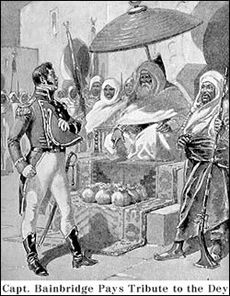
Piracy was such a big problem that some countries started programs to free their citizens. In Denmark, money was collected in churches. A "slave fund" was set up by the state in 1715. Sailors had to pay into this fund. Between 1716 and 1736, 165 slaves were freed using this money. From 1716 to 1754, nineteen ships from Denmark-Norway were captured, with 208 men. Piracy was a serious threat to Danish trade ships.
During the American Revolutionary War, pirates attacked American merchant ships. However, on December 20, 1777, Sultan Mohammed III of Morocco said that America was an independent country. He stated that American merchant ships could travel safely in the Mediterranean. Relations were made official with the Moroccan–American Treaty of Friendship in 1786. This is the oldest unbroken friendship treaty the U.S. has with another country.
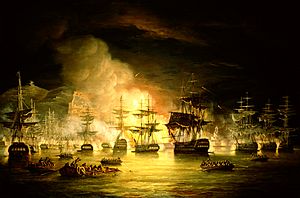
Before America's independence in 1776, British agreements with the North African states protected American ships. But in 1784, Morocco, which was the first independent nation to recognize the United States, became the first Barbary power to seize an American ship. The Barbary threat led directly to the United States creating the United States Navy in March 1794.
Even though the U.S. made peace treaties with the Barbary states, it had to pay money for protection. This was a huge cost. From 1795, the yearly payment to the Regency of Algiers was 20% of the U.S. government's total yearly spending.
In 1798, Tunisians attacked a small island near Sardinia. More than 900 people were taken as slaves.
The Barbary states found it hard to stop slave-raiding completely. This was because it was a very important part of their economy. Slavers kept taking captives from less protected groups. Algiers continued its slave-raiding, but on a smaller scale. European leaders at the Congress of Aix-la-Chapelle in 1818 talked about how to respond. In 1824, a British fleet under Admiral Sir Harry Burrard Neale attacked Algiers. Pirate activity from Algiers finally stopped when France conquered the state in 1830.
Life as a Barbary Slave
From their bases on the Barbary coast, pirates raided ships in the Mediterranean. They also attacked coasts of Africa, Europe, and even as far as Iceland. They stole goods and enslaved the people they captured. Sometimes, whole towns, like Baltimore in Ireland, were left empty after a raid. Between 1609 and 1616, England alone lost 466 merchant ships to Barbary pirates.
Slave Prisons
At night, slaves were kept in prisons called 'bagnios'. These places were often hot and crowded. Bagnios sometimes had chapels, hospitals, shops, and bars run by the captives themselves.
Galley Slaves
Life in bagnios was hard, but it was often better than being a galley slave. Most Barbary galleys were at sea for about 80 to 100 days a year. When slaves were on land, they were forced to do hard manual labor.
However, some galley slaves, like those for the Ottoman Sultan in Constantinople, were always kept on their galleys. They often served for a very long time, sometimes around nineteen years. These slaves rarely left the galley and lived there for years. Rowers were chained to their seats and could not leave. They ate and slept right where they were shackled. Usually, five or six rowers worked on each oar.
How Many People Were Enslaved?
Historian Robert Davis believes that between 1 million and 1.25 million Europeans were captured by Barbary pirates. They were sold as slaves in North Africa and the Ottoman Empire from the 1500s to the 1800s.
To estimate these numbers, Davis assumed that the number of European slaves captured stayed the same for 250 years. He said:
There are no records of how many men, women and children were enslaved. But we can guess how many new captives were needed each year. This would keep the slave population steady and replace those who died, escaped, were freed, or became Muslim. Based on this, about 8,500 new slaves were needed each year. This means about 850,000 captives over the century from 1580 to 1680. For the 250 years between 1530 and 1780, the number could easily have been as high as 1,250,000.
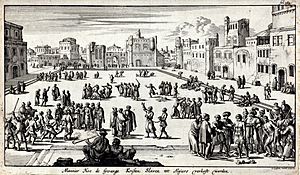
Historians liked that Davis tried to count the slaves. But they disagreed about how accurate his method was, since there were no written records. Historian David Earle, author of The Corsairs of Malta, questioned Davis's numbers. He said they "sound a bit dodgy" and might be too high. He also noted that the true picture is unclear because corsairs also captured non-Christian white people from Eastern Europe and black people from West Africa.
Professor Ian Blanchard, an expert on African trade, said Davis's work was good. He thought a number over a million was likely. Davis notes that his calculations were based on reports from the late 1500s and early 1600s. These reports said there were about 35,000 European Christian slaves on the Barbary Coast at any one time. Most were in Algiers, with others in Tripoli and Tunis.
Lasting Impact
The history of Muslims enslaving white Europeans has been mentioned by some. It helps to understand the later enslavement of black people by Europeans and Americans. Scholar Robert Davis noted that history is not one-sided. During a "clash of empires," taking slaves was part of the conflict. At the same time that 2 million Europeans were enslaved by Muslims, 1 million Muslim slaves were in Europe.
Dr. John Callow notes that being enslaved by Barbary pirates happened before the Atlantic slave trade. He says that the memory of slavery and how it was done was deeply felt by the British. For them, it was first linked to North Africa, where Britons were more likely to be slaves than slave owners.
Famous Barbary Corsairs
According to historian Adrian Tinniswood, the most well-known corsairs were Europeans who had changed their religion. They had learned their skills as privateers (legal pirates working for a government). When wars ended, they moved to the Barbary Coast to continue their work. These outcasts, who became Muslim, brought modern naval skills to piracy. This allowed the corsairs to make long-distance slave-catching raids. They went as far as Iceland and Newfoundland.
A famous corsair, Henry Mainwaring, was first a lawyer and pirate-hunter. He later returned home and received a royal pardon. Mainwaring then wrote a book about piracy in the Mediterranean. It was called Discourse of Pirates. In the book, Mainwaring suggested ways to find and stop piracy.
The Barbarossa Brothers
Oruç Barbarossa
The most famous corsairs in North Africa were the Barbarossa brothers, Aruj and Khayr al-Din. They and two other brothers became Barbary corsairs working for the Ottoman Empire. They were called the Barbarossas (Italian for Redbeards) because Oruç, the oldest, had a red beard.
Oruç captured the island of Djerba for the Ottoman Empire in 1502 or 1503. He often attacked Spanish lands on the North African coast. During one failed attempt in 1512, he lost his left arm to a cannonball. Oruç also took over Algiers in 1516 with help from the Ottoman Empire. He executed the ruler of Algiers and anyone he thought would oppose him. The Spanish finally captured and killed him in 1518, and displayed his body.
Hızır Hayreddin Barbarossa
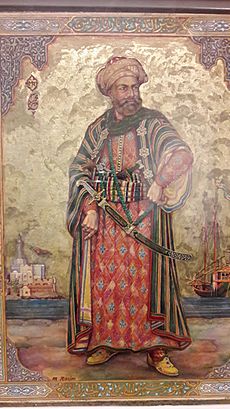
Oruç, who mostly fought on land, was not as famous as his youngest brother, Hızır. Hızır (later called Hayreddin or Kheir ed-Din) was a more typical corsair. He was a skilled engineer and spoke at least six languages. He dyed his hair and beard with henna to make them red like Oruç's.
After capturing many important coastal areas, Hayreddin became the chief admiral of the Ottoman sultan's fleet. Under his command, the Ottoman Empire controlled the Mediterranean for over thirty years. Barbaros Hızır Hayreddin Pasha died in 1546 from a fever, possibly the plague.
Captain Jack Ward
English corsair Jack, or John, Ward was once called "the greatest scoundrel that ever sailed from England" by the English ambassador to Venice. Ward was a privateer for Queen Elizabeth during her war with Spain. After the war, he became a corsair. Around 1603, he and his friends captured a ship and sailed it to Tunis. He and his crew became Muslim. He became very successful and rich.
He brought heavily armed square-rigged ships to North Africa. These ships were used instead of galleys and were a big reason for the Barbary corsairs' future power in the Mediterranean. He died of plague in 1622.
Sayyida al-Hurra
Sayyida al-Hurra was a female Muslim leader, merchant, and governor of Tétouan. She later became the wife of the sultan of Morocco. She was born around 1485 in Emirate of Granada. But she had to flee to Morocco when she was very young to escape the Reconquista. In Morocco, she gathered a crew, mostly of exiled Moors. She launched pirate attacks against Spain and Portugal. Her reasons were to get revenge for the Reconquista, protect Morocco from Christian pirates, and gain wealth and fame.
Sayyida al-Hurra became rich and famous enough for the Sultan of Morocco, Ahmad al-Wattasi, to make her his queen. She famously refused to marry him in his capital of Fez. She insisted on marrying in Tétouan, where she was governor. This was the first and only time a Moroccan ruler had married away from his capital.
Raïs Hamidou
Hamidou ben Ali, known as Raïs Hamidou (Arabic: الرايس حميدو), was an Algerian corsair. He was born around 1770 and died on June 17, 1815, near Cape Gata off the coast of southern Spain. He captured up to 200 ships during his career. Hamidou helped the Deylik of Algiers become wealthy and famous. He gave it its last period of glory before the French invasion. His life story is well known because a French historian found important documents, including a special "register of prizes" kept by the Deylik's authorities. Songs and legends also tell stories about this famous person.
In Fiction
Barbary corsairs appear in many stories. They are main characters in Le pantere di Algeri by Emilio Salgari. They are also in famous novels like Robinson Crusoe by Daniel Defoe and The Count of Monte Cristo by Alexandre Dumas, père. Other books include The Sea Hawk by Rafael Sabatini and Master and Commander by Patrick O'Brian.
Miguel de Cervantes, a Spanish writer, was held captive for five years as a slave in Algiers. He wrote about his experiences in some of his fictional works. These include the Captive's tale in Don Quixote and his plays El Trato de Argel and Los Baños de Argel.
In Mozart's opera Die Entführung aus dem Serail, two European ladies are found in a Turkish palace, likely captured by Barbary corsairs. Rossini's opera L'italiana in Algeri is about several slaves captured by Barbary corsairs led by the ruler of Algiers.
See also
- Barbary slave trade
- Barbary treaties
- History of slavery in the Muslim world
- Morocco–United States relations
- Ottoman Navy
- Republic of Salé
- Slavery in the Ottoman Empire
- Turkish Abductions



